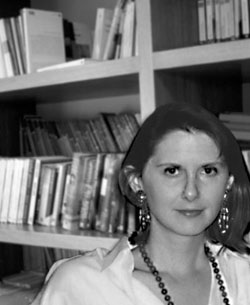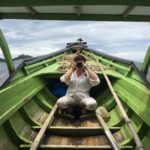C.M. Mayo is the author of Miraculous Air: Journey of a Thousand Miles through Baja California, the Other Mexico, and Sky Over El Nido, which won the Flannery O’Connor Award for Short Fiction. Mayo’s travel writing has appeared in the Los Angeles Times, the Wall Street Journal, and numerous literary journals, among them, Creative Nonfiction, Fourth Genre, and the North American Review. Her work has been recognized with numerous fellowships (among them, to the Bread Loaf and Sewanee writers conferences, MacDowell, and Yaddo), and two of her essays won Lowell Thomas Awards in 2003.
How did you get started traveling?
I’ve never thought of travel as something I started doing; I’ve been traveling ever since I can remember — beginning with cross-country car trips. By the time I was in my mid-twenties, I’d been all over North America, to Asia, Europe several times, and to North Africa. Then, I moved to Mexico City, where I still have a house. The motivation for writing Miraculous Air was that after ten years of living in Mexico City, I was so sick of the crime, the pollution, the traffic, that I wanted to leave. But rather than go back to the US, I thought, why not re-approach Mexico by exploring a part of it that I don’t know? And that was Baja California, the nearly 1,000 mile-long peninsula known to many as “the Other Mexico”.
How did you get started writing?
Same answer – I’ve been writing ever since I knew how to put words on paper.
What do you consider your first “break” as a writer?
In the mid-1980s I was working as an economist in a Mexico City investment bank and the editor of El Inversionista came by, trolling for material. So I handed him a dry-as-bones “Outlook for Petroleum Prices”. But I got such a charge to see my work in print, I just kept on going — some 50 articles and two books on Mexican and international finance. Then, when I began doing literary writing, my first important break was having a short story accepted by the Paris Review.
As a traveler and fact/story gatherer, what is your biggest challenge on the road?
To “be here now,” as the sages say, and that takes stamina. To be able to fully experience a place, and convey that to readers, I need to stay laser-focused on what I’m seeing, hearing, tasting, smelling, touching, feeling, and in interviews especially, I need to listen with a genuinely open heart. (And keep taking notes at what often turns out to be a wrist-breaking pace!) So I try to get a lot of sleep, and not pack too much into any given day. For Miraculous Air, though the subtitle “Journey of a Thousand Miles through Baja California, the Other Mexico” suggests a single trip, in fact, I made several. At the start, I had envisioned a single, arrow-like trip, reported as a kind of lyrical poem. But that wasn’t what the book wanted to be. The material was much too rich.
What is your biggest challenge in the research and writing process?
Patience and again, stamina.
What is your biggest challenge from a business standpoint? Editors? Finances? Promotion?
I’ve been extraordinarily lucky with my editors, especially Dawn Marano, my editor for Miraculous Air. The challenge for me — as for many other writers I know — has been learning how to surf in these crazy, choppy waters of the book business. What one might have expected to work 10 years ago, no longer does. When I started out, the paradigm seemed to me to be, you find an agent, the agent finds you a publisher, and there you are, book after book. With all the mergers and acquisitions in the industry — which means editors coming and going — this is no longer necessarily the case. Another change in the rise of the chain-stores and decline of the independents. And with the Internet, book markets are blowing wide open. For example, I now sell a lot of my books through on-line sellers such as Amazon.com and specialty sellers, such as Longitude.com (travel books) and BajaBooksandMaps.com. For me, this has been wonderful. And your website, Rolf, with these interviews, is a concept that would have been unthinkable 15 years ago.
Have you ever done other work to make ends meet?
I worked in futures and options in an investment bank, and for several years I taught in the economics department in ITAM, a Mexican university modeled on MIT.
What travel authors or books might you recommend and/or have influenced you?
V.S. Naipaul’s A Turn in the South is so elegant — his prose is like the perfect flan, mild and smooth. And I do not think there has been a more original and profound book yet written about the American South. I read this book three times, trying to figure out how he had structured it. Basically, Naipual focused on one state per chapter, beginning in Atlanta, Georgia and ending in Chapel Hill, North Carolina. But within this structure, he let each journey, each interview, each incident unfold into his story in an almost organic way.
Near the end of the book, Naipaul writes, “It is often enough for the traveler… to say, more or less, ‘This is me here. This is me getting off the old native bus and being led by strange boys, making improper proposals, to some squalid lodging. This is me having a drink in a bar with some local characters. This is me getting lost later that night.’ This kind of traveler is not really a discoverer. He is more a man defining himself against a foreign background…” Then, Naipaul goes on: “I had been concerned, from the start of my own journey, to establish some lines of inquiry, to define a theme…. If you travel on a theme, the theme has to develop with the travel. At the beginning your interests can be broad and scattered. But then they must be more focused; the different stages of a journey cannot simply be versions of one another. And, more than the other kind of travel, this traveling on a theme depended on luck. It dependened on the people you met, the little illuminations you had. As with the next day’s issue of a fast-moving daily newspaper, the shape of the chapter in hand was continually being changed by accidents along the way.”
So, emulating Naipaul’s structure, I decided to travel from the tip of Baja California, through the middle, to the Sea of Cortes, then to the Pacific, and finally to the US border — five sections. As for a theme, I was trying to discover “the Other Mexico,” what made it Mexican, and what made it different from mainland Mexico, and finding out what I could, examining how this would change my perceptions of Mexico itself. Emulating Naipaul, I interviewed a wide variety of people, workers, business people, artists — anyone who could give me insight into this theme. And I remained as open as I could to what was happening around me during my travels.
Another writer whose work has infomed mine is Ted Conover. He is a master at what I think of as “wedging in” information in such a way that the narrative remains vividly novelistic. In other words, though he does provide the heavy-duty technical/ sociological/ historical/ etc background, he never once lapses into “textbook-ese”. I admire all of Conover’s books, but his most recent, Newjack: Guarding Sing Sing, is, I think, his best. Another master at “wedging in” is Ian Frazier, especially in his travel memoir Great Plains. Plus, Frazier has a wacky sense of humor.
On Baja California specifically, I began with Graham Mackintosh’s rollicking Into a Desert Place. He’s an adventure traveler of the old school — fantastic, death-defying adventure. He literally walked around the entire coastline of Baja California, something no one had ever done before. I’ve met him: he has a great spirit. There is, of course, John Steinbeck’s 1941 classic, The Log from the Sea of Cortez. Harry Crosby’s Cave Paintings of Baja California records his epic travels in search of the indigenous rock art sites; I have all of Erle Stanley Gardner’s books about his many fiesta-like adventures; Arthur North’s Camp and Camino, now nearly a century old, remains vivid in my mind. I should also mention the reports of the Jesuit missionaries. These are extremely strange, with almost dreamlike quality. These Jesuits were — literally — the conquerers, beginning in the 17th century.
There are so many writers whose work I’ve enjoyed and learned from — I could go on for paragraphs, but to limit the list to the three most recent travel books I’ve read and would highly recommend: Gretel Erhlich, This Cold Heaven: Seven Seasons in Greenland; Sara Mansfield Taber, Bread of Three Rivers: The Story of a French Loaf; and Jan Morris, Trieste and the Meaning of Nowhere.
What advice and/or warnings would you give to someone who is considering going into travel writing?
My main advice would be, if you want to do it, do it. Why wait? If you don’t have the funds to take off for, say, Chang Mai, why not write about a neighborhood in your own town or city? Or a creek? Or the people who fish in that creek? Or are trying to save that creek? Subjects are nearby, and infinite. Take the craft seriously — and study poetry because it’s all poetry.
What is the biggest reward of life as a travel writer?
The world is yours. You can delve into flora, fashion, history, art, conflict, shamanism, political shenanigans, geography, the life cycle of a turtle, a gazillion different things, and, in my experience, almost anyone will talk to you. In researching Miraculous Air, I interviewed goat ranchers, painters, an installation artist, a priest, a street vendor, a social worker, a world-class architect, the owner of a sport-fishing fleet, a housewife, tomato pickers, a construction worker, and a surf star, just to mention a few. With paper and pen, and a sincere willingness to listen, and to really look, it’s as if all the curtains magically rise up.





